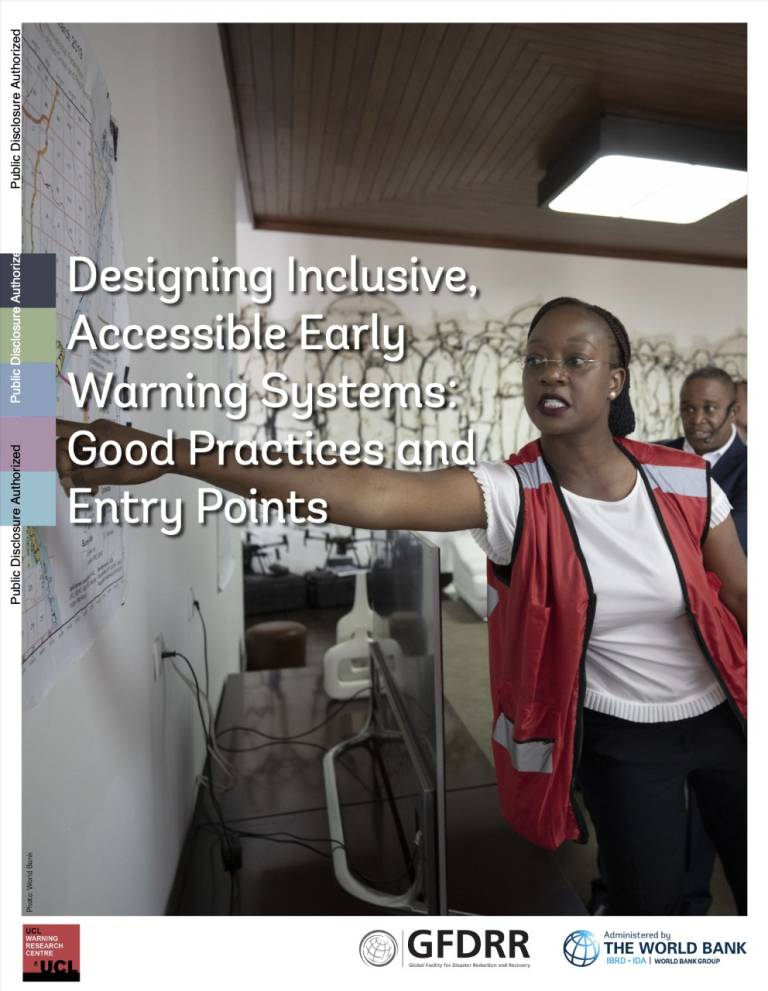Designing Inclusive, Accessible Early Warning Systems: Good Practices and Entry Points
5 May 2023
The new report was commissioned by the Global Facility for Disaster Reduction and Recovery (World Bank) to present key lessons and areas of good practice from specific examples, along with recommendations and entry points for inclusive, accessible early warning systems (EWS).

This guidance note was prepared by Rebekah Yore, Carina Fearnley, Maureen Fordham, and Ilan Kelman of the UCL Warning Research Centre.
This report presents key lessons and areas of good practice from specific examples, along with recommendations and entry points for inclusive, accessible early warning systems (EWS). It is aimed at development practitioners, especially World Bank staff, working with communities and governments to provide evidence-based approaches to enhance inclusion of different social groups in EWS, depending on the local context. It is not intended to be a comprehensive overview of a robust, effective EWS, but rather to highlight key points for the inclusivity components of multi-hazard impact-based EWS. The report builds on the premise that adopting pragmatic, contextually tailored approaches to design and implementation of EWS produces better, more effective and inclusive outcomes and reaches more-diverse populations than one-size-fits-all models.
Designing and implementing inclusive EWS requires careful consideration of the distinct needs and abilities of diverse groups to prepare for and respond to disasters. Exclusion of certain groups from the early warning notification process can result in adverse consequences, particularly for marginalized communities, which may already be at heightened risk during disasters or emergencies. For example, persons with disabilities require notifications in accessible formats, such as through audio or visual alerts or assistive technologies. Similarly, addressing the needs of women and girls requires safe spaces for women, trained responders’ gender-based violence and gender-sensitive notification. By promoting equity and mitigating vulnerability, inclusive EWS can help to safeguard lives, decrease the impact of disasters on communities, and foster long-term resilience.
Inclusive, accessible EWS have characteristics that are consistent across the case studies presented in the report. They:
- Are long-term social processes.
- Use multiple channels, modes, and messages that are clear, transparent, consistent, and credible.
- Are relevant to everyone, covering a range of timeframes and geographic coverage.
- Connect all governance levels, including local, national, and international.
- Require including the needs of different social groups to respond to multiple hazards, sequences, and cascading events.
- Extend beyond warning dissemination to include damage prevention, mitigation actions, and response conditions to ensure capacity to act.
- Facilitate early and anticipatory action, which also reduces inequalities and inequities regardless of the hazard.
The report provides entry points and good practices for designing more inclusive, accessible early warnings and is organized around the four key elements of effective end-to-end EWS. The entry points are supplemented with case studies and identification of gaps and actions that illustrate activities related to the EWS element.
Key conclusions and recommendations include:
- Engage diverse communities and stakeholders from the beginning: Finance continual engagement processes for people and organisations to identify and fulfil their own warning needs without excluding or inhibiting others.
- Integrate iteration and adaptive learning: Collaborate with and be directed by people and organisations applying warnings to build trust and credibility for integrating long-term warning processes into everyone’s daily lives and governance practices.
- Support initiatives and activities that create an enabling environment: Establish good practices, entry points, and comparable data while recognising limitations in safe data collection, replicability, transferability, and scaling.
The evidence shows that taking practical approaches to inclusion in warnings has better outcomes and reaches more groups than one-size-fits-all models.
Full report available for free download:
Designing Inclusive, Accessible Early Warning Systems
Launch Event - hosted by GFDRR
The report was formally launched during an online event on 2 May 2023; the recording can now be viewed on YouTube or as embedded below.
Our sponsors: Global Facility for Disaster Reduction and Recovery (administered by the World Bank)
We thank Simone Balog-Way, Ann-Maria Bogdanova, Jana El-Horr, Mirtha Liliana Escobar, Yulia Krylova, Cristina Otano, Makoto Suwa, Zoe Trohanis, and Vladimir Tsirkunov for commissioning this report, and their support and guidance in developing the report.
The Global Facility for Disaster Reduction and Recovery (GFDRR) is a multi-donor partnership that supports low and middle-income countries to understand, manage, and reduce their risks from natural hazards and climate change. Established in 2006, GFDRR is uniquely positioned to scale the resilience agenda in these countries by providing funding and expertise for policy advice on improving disaster risk management (DRM) at national and local levels, as it relates to land use, building codes, public health, transport, and education, agriculture, environmental protection, energy, water resources management, poverty reduction, fiscal risk management, and climate change adaptation, among others. This advice, in the context of the World Bank’s policy-based lending, creates both technical capacity and financial incentives that enables formalization of policy changes for improved DRM. The Program Management Unit, located within the World Bank, manages grant resources to carry out GFDRR’s mission. Learn more here: https://www.gfdrr.org/en.
 Close
Close

